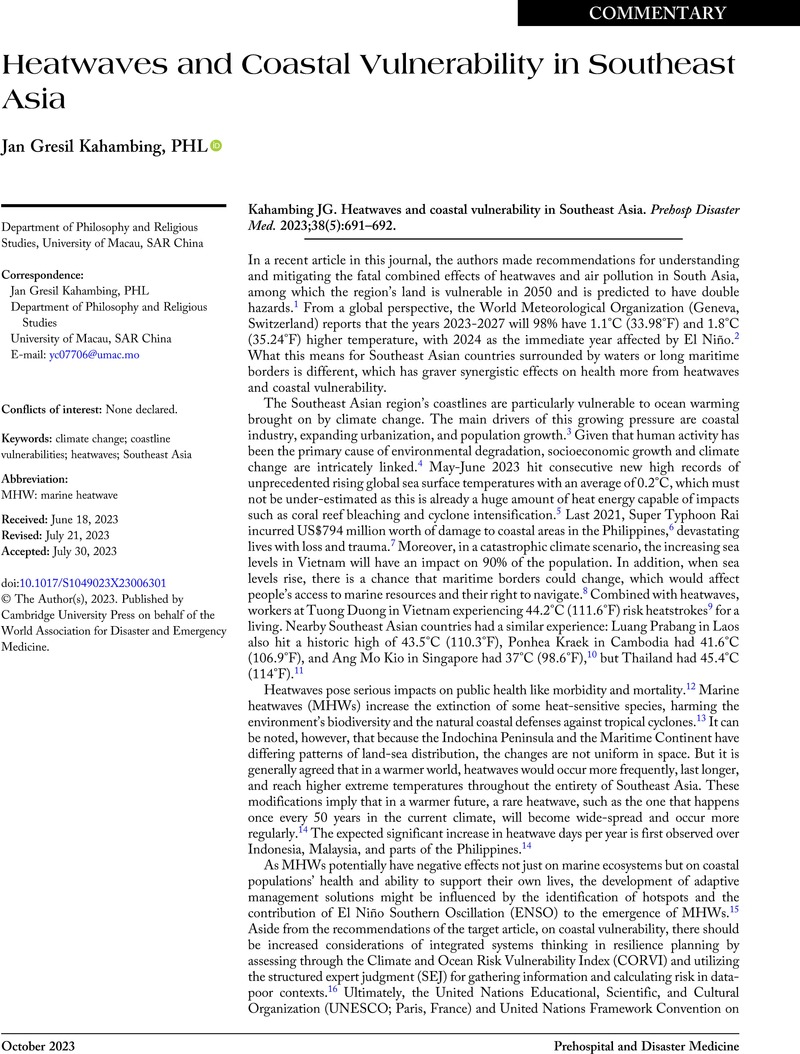No CrossRef data available.
Article contents
Heatwaves and Coastal Vulnerability in Southeast Asia
Published online by Cambridge University Press: 29 August 2023
Abstract
An abstract is not available for this content so a preview has been provided. Please use the Get access link above for information on how to access this content.

- Type
- Article Commentary
- Information
- Copyright
- © The Author(s), 2023. Published by Cambridge University Press on behalf of the World Association for Disaster and Emergency Medicine
References
Hasan, S, Tamim, AR, Patwary, MM, et al. Heatwaves and air pollution: a deadly combination for human health in South Asia. Prehosp Disaster Med. 2023;38(2):274–275.CrossRefGoogle ScholarPubMed
World Meteorological Organization. Global temperatures set to reach new records in next five years. 2023. https://public.wmo.int/en/media/press-release/global-temperatures-set-reach-new-records-next-five-years. Accessed May 30, 2023.Google Scholar
Noor, NM, Abdul Maulud, KN. Coastal vulnerability: a brief review on integrated assessment in Southeast Asia. Journal of Marine Science and Engineering. 2022;10(5):595.10.3390/jmse10050595CrossRefGoogle Scholar
Roukounis, CN, Tsihrintzis, VA. Indices of coastal vulnerability to climate change: a review. Environmental Processes. 2022;9(2):29.CrossRefGoogle Scholar
World Meteorological Organization. Air and sea surface temperatures hit new records. 2023. https://public.wmo.int/en/media/news/air-and-sea-surface-temperatures-hit-new-records. Accessed June 17, 2023.Google Scholar
Llorca, SM, Abiera, A, Gazo, D, Edilo-Astronomo, S, Kahambing, JG. Bioethics as mental health? The core response on Typhoon Rai in Southern Leyte, Philippines. MALIM [Journal of Southeast Asian General Studies]. 2022;23:214–224.Google Scholar
Abiera, A, Kahambing, JG. Loss, trauma, and the future for college students during Super Typhoon Rai. Journal of Loss and Trauma. 2023;28(7):647–649.CrossRefGoogle Scholar
Gong, L. Climate-induced disasters as an evolving threat to Southeast Asia’s maritime security. Asia Maritime Transparency Initiative. 2022. https://amti.csis.org/climate-induced-disasters-as-an-evolving-threat-to-southeast-asias-maritime-security/. Accessed May 30, 2023.Google Scholar
Dotto, C, Shveda, K, Robinson, L. A ‘once-in-200 years’ heat wave caught Southeast Asia off guard. Climate change will make them more common. CNN World. https://edition.cnn.com/2023/06/06/asia/southeast-asia-heat-wave-humidity-climate-intl-hnk-dst-scn-dg/index.html. Accessed June 10, 2023.Google Scholar
South-East Asia is in the grip of a record-breaking heatwave. The Economist. 2023. https://www.economist.com/graphic-detail/2023/05/17/south-east-asia-is-in-the-grip-of-a-record-breaking-heatwave. Accessed May 30, 2023.Google Scholar
Igini, M. Vietnam, Laos, and Thailand Set New All-Time National Heat Records as Prolonged Asian Heatwave Concerns Scientists. Earth.Org. 2023. https://earth.org/southeast-asia-heatwave/. Accessed May 28, 2023.Google Scholar
Li, X-X, Yuan, C, Hang, J. Heat wave trends in Southeast Asia: comparison of results from observation and reanalysis data. Geophysical Research Letters. 2022;49(4):e2021GL097151.CrossRefGoogle Scholar
Androulidakis, YS, Kourafalou, V. Marine heat waves over natural and urban coastal environments of South Florida. Water. 2022;14(23):3840.10.3390/w14233840CrossRefGoogle Scholar
Dong, Z, Wang, L, Sun, Y, et al. Heatwaves in Southeast Asia and their changes in a warmer world. Earth’s Future. 2021;9(7):e2021EF001992.10.1029/2021EF001992CrossRefGoogle Scholar
Edullantes, B, Concolis, BM, Quilestino-Olario, R, Atup, DP, Cortes, A, Yñiguez, A. Characteristics of marine heatwaves in the Philippines. Regional Studies in Marine Science. 2023;62:102934.CrossRefGoogle Scholar
Rouleau, T, Stuart, J, Call, M, et al. The climate and ocean risk vulnerability index: measuring coastal city resilience to inform action. Front Sustain Cities. 2022;4:884212.10.3389/frsc.2022.884212CrossRefGoogle Scholar
Leal Filho, W, Sima, M, Sharifi, A, et al. Handling climate change education at universities: an overview. Environ Sci Eur. 2021;33(1):109.10.1186/s12302-021-00552-5CrossRefGoogle ScholarPubMed
Kahambing, JG, Lao, TW. The value of museums in averting a planetary health crisis. Ethics, Medicine, and Public Health. 2023;26:100866.10.1016/j.jemep.2022.100866CrossRefGoogle Scholar



